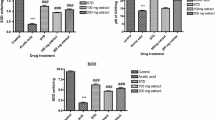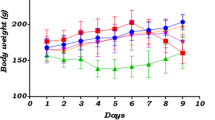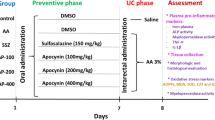Abstract
The efficacy of comaruman CP, a pectin of marsh cinquefoil Comarum palustre L., was investigated using a model of acetic acid-induced colitis in mice. Mice were administered comaruman CP orally 2 days prior to rectal injection of 5% acetic acid and examined for colonic damage 24 hr later. Colonic inflammation was characterized by macroscopical injury, higher levels of myeloperoxidase activity, enhanced vascular permeability, and diminution of colonic mucus. Oral administration of comaruman CP was found to prevent progression of colitis. Colonic macroscopic scores and the total square of damage were significantly reduced in mice treated with CP compared with the vehicle-treated colitis group. Peroral pretreatment of mice with comaruman CP was shown to decrease tissue myeloperoxidase activity in colons compared with the colitis group. Comaruman CP was found to stimulate production of mucus by colons of normal and colitis mice. Comaruman CP decreased the inflammatory status of normal mice as elicited by reduction of vascular permeability and adhesion of peritoneal neutrophils and macrophages. Thus, a preventive effect of comaruman on acetic acid-induced colitis in mice was detected. Reduction of neutrophil infiltration and enhancement of colon-bound mucus may be implicated in the protective effect of comaruman.




Similar content being viewed by others
References
Podolsky DK (2002) Inflammatory bowel disease. N Engl J Med 347:417–429
Hendrickson BA, Gokhale R, Cho JH (2002) Clinical aspects and pathophysiology of inflammatory bowel disease. Clin Microbiol Rev 15:79–94
Lipkin M, Reddy B, Newmark H, Lamprecht SA (1999) Dietary factors in human colorectal cancer. Annu Rev Nutr 19:545–586
Thakur BR, Singh RK, Handa AK (1997) Chemistry and uses of pectin—A review. Crit Rev Food Sci Nutr 37:47–73
Rolandelli RH, Saul SH, Settle RG, Jacobs DO, Trerotola SO, Rombeau Jl (1988) Comparison of parenteral nutrition and enteral feeding with pectin in experimental colitis in the rat. Am J Clin Nutr 47:715–721
Lim BO, Lee SH, Park DK, Choue RW (2003) Effect of dietary pectin on the production of immunoglobulins and cytokines by mesenteric lymph node lymphocytes in mouse colitis induced with dextran sulfate sodium. Biosci Biotechnol Biochem 67:1706–1712
Barcelo A, Claustre J, Moro F, Chayvialle JA, Cuber JC, Plaisancie P (2000) Mucin secretion is modulated by luminal factors in the isolated vascularly perfused rat colon. Gut 46:218–224
Schimidgall J, Hensel A (2002) Bioadhesive properties of polygalacturonides against colonic epithelial membranes. Int J Biol Macromol 30:217–225
Ovodov YuS (1998) Polysaccharides of phanerogams:structure and physiological activity. Russ J Bioorgan Chem 24:423–439
Popov SV, Popova GYu, Ovodova RG, Ovodov YuS (2005) Anti-inflammatory activity of the pectic polysaccharide from Comarum palustre L. Fitoterapia 76:281–287
Popov SV, Ovodova RG, Popova GYu, Nikitiina IR, Ovodov YuS (2005) Adhesion of human neutrophils to fibronectin is inhibited by comaruman, pectin of marsh cinquefoil Comarum palustre L., and by its fragments. Biochemistry (Mosc) 70:108–112
Iton H, Kataoka H, Tomita M, Hamasuna R, Nawa Y, Kitamura N, Koono M (2000) Upregulation of HGF activator inhibitor type 1 but not type 2 along with regeneration of intestinal mucosa. Am J Physiol Gastrointest Liver Physiol 278:635–643
Ovodova RG, Bushneva OA, Shashkov AS, Chizhov AO, Ovodov YuS (2005) Structural study of pectin of marsh cinquefoil Comarum palustre L. Biochemistry (Mosc) 70:1051–1062
Mahgoub AA, El-Medany AA, Hager HH, Mustafa AA, El-Sabah DM (2003) Evaluating the prophylactic potential of zafirlukast against the toxic effects of acetic acid on the rat colon. Toxicol Lett 145:79–87
Evans M, Laszlo F, Brendan J, Whittle R (2000) Site-specific lesion formation, inflammation and inducible nitric oxide synthase expression by indomethacin in the rat intestine. Eur J Pharm 388:281–285
Blandizzi C, Natale G, Gherardi G, Lazzeri G, Marveggio C, Colucci R, Carignani D, Del Tacca M (1999) Acid-independent gastroprotective effects of lansoprazole in experimental mucosal injury. Dig Dis Sci 44:2039–2050
Pereira BMR, da Silva BP, Pereira NA, Parente JP (2000) Anti-inflammatory and immunologically active polysaccharides of Periandra mediterranea. Phytochemistry 54:409–413
Fraser I, Huges D, Gordon S (1993) Divalent cation-independent macrophage adhesion inhibited by monoclonal antibody to murine scavenger receptor. Nature 364:343–346
Englyst NH, Quigley ME, Hudson GJ (1995) Definition and measurement of dietary fibre. Eur J Clin Nutr 49:48–62
Umar S, Morris AP, Kourouma F, Sellin JH (2003) Dietary pectin and calcium inhibit colonic proliferation in vivo by differing mechanisms. Cell Prolif 36:361–375
Cook SI, Sellin JN (1998) Review article: short chain fatty acids in health and disease. Aliment Pharmacol Ther 12:499–507
Cameron IL, Hardman WE, Heitman DW, Carter JW (2000) Dietary fibre on cell proliferation in large bowel mucosal crypts near or away from lymphoid nodules and on mineral bioavailability. Cell Prolif 33:367–379
Stark A, Nyska A, Madar Z (1996) Metabolic and morphometric changes in small and large intestine in rats fed high-fiber diets. Toxicol Pathol 24:166–170
Deng GY, Liu YW, He GZ, Jiang ZM (1999) Effect of dietary fiber on intestinal barrier function of 5-Fu stressed rats. Res Exp Med 199:111–119
Pooley N, Ghosh L, Sharon P (1995) Up-regulation of E-selectin and intercellular adhesion molecule-1 differs between Crohn's disease and ulcerative colitis. Dig Dis Sci 40:219–225
Boismenu R, Chen Y (2000) Insights from mouse models of colitis. J Leukoc Biol 67:267–278
Nusrat A, Parkos CA, Liang TW, Carnes DK, Madara JL (1997) Neutrophil migration across model intestinal epithelia:monolayer disruption and subsequent events in epithelial repair. Gastroenterology 113:1489–1500
Krawisz JE, Sharon P, Stenson WF (1984) Quantitative assay for acute intestinal inflammation based on myeloperoxidase activity. Gastroenterology 87:1344–1350
Eftimiadi C, Buzzi E, Tonetti M, Buffa P, Buffa D, van Steenberg MT, de Graaf J, Botta GA (1987) Short-chain fatty acid produced by anaerobic bacteria alter the physiological responses of human neutrophils to chemotactic peptide. J Infect 14:43–53
Inase N, Schreck RE, Lazarus SC (1993) Heparin inhibits histamine release from canine mast cells. Am J Physiol 264:L387–L390
Acknowledgments
This work was supported by the programs “Molecular and Cellular Biology” and “Fundamental Sciences—to Medicine” of the Presidium of the RAS and by the Russian Fund for Basic Research (Grant 03-04-48136).
Author information
Authors and Affiliations
Corresponding author
Rights and permissions
About this article
Cite this article
Popov, S.V., Ovodova, R.G., Markov, P.A. et al. Protective Effect of Comaruman, a Pectin of Cinquefoil Comarum palustre L., on Acetic Acid-Induced Colitis in Mice. Dig Dis Sci 51, 1532–1537 (2006). https://doi.org/10.1007/s10620-005-9034-8
Received:
Accepted:
Published:
Issue Date:
DOI: https://doi.org/10.1007/s10620-005-9034-8




